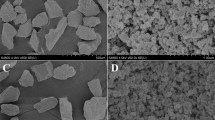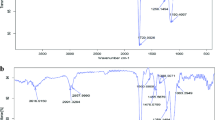Abstract
A novel room temperature phosphorescence chemosensor probe has been successfully developed and applied to the selective detection and quantification of inorganic arsenic (As(III) plus As(V)) in fish samples. The prepared material (IIP@ZnS:Mn QDs) was based on Mn-doped ZnS quantum dots coated with (3-aminopropyl) triethoxysilane and an As(III) ionic imprinted polymer. The novel use of vinyl imidazole as a complexing reagent when synthesizing the ionic imprinted polymer guarantees that both inorganic arsenic species (As(III) and As(V)) can interact with the recognition cavities in the ionic imprinted polymer. After characterization, several studies were performed to enhance the interaction between the targets (As(III) and As(V) ions) and the IIP@ZnS:Mn QDs nanoparticles. The optimization and validation process showed that the composite material offers high selectivity (high imprinting factor) for inorganic arsenic species. The limit of quantification for total inorganic As was 29.6 μg kg−1, value lower than the EU/EC regulation limits proposed for other foodstuffs than fish, such as rice. The proposed method is therefore simple, requires short analysis times and offers good sensitivity, precision (inter-day relative standard deviations lower than 10%), and quantitative analytical recoveries. The method has been successfully applied to assess total inorganic arsenic in several fishery products, showing good agreement with the total inorganic arsenic concentration (As(III) plus As(V)) found after applying other advanced and expensive methods such those based on high-performance liquid chromatography hyphenated to inductively coupled plasma-mass spectrometry.

Graphical abstract





Similar content being viewed by others
References
Liu CW, Liang CP, Huang FM, Hsueh YM. Assessing the human health risks from exposure of inorganic arsenic through oyster (Crassostrea gigas) consumption in Taiwan. Sci Total Environ. 2006;361:57–66.
ATSDR (2017) ATSDR’s Substance Priority List. Agency for toxic substances and disease registry. https://www.atsdr.cdc.gov/SPL/. Accessed 20 December 2018.
IARC (2018) IARC monographs on the evaluation of carcinogenic risk to human. https://monographs.iarc.fr/list-of-classifications-volumes/. Accessed 29 December 2018.
Tidwell JH, Allan GH. Fish as a food: aquaculture’s contribution. EMBO Rep. 2001;2(11):958–63.
Meharg AA, Lombi E, Williams PN, Scheckel KG, Feldmann J, Raab A, et al. Speciation and localization of arsenic in white and brown rice grains. Environ Sci Technol. 2008;42:1051–7.
Gao Y, Baisch P, Mirlean N, Rodrigues da Silva JFM, Van Larebeke N, Baeyens W, et al. Arsenic speciation in fish and shellfish from the North Sea (Southern bight) and Açu Port area (Brazil) and health risks related to seafood consumption. Chemosphere. 2018;191:89–96.
Wei X, Zhou Z, Dai J, Hao T, Li H, Xu Y, et al. Composites of surface imprinting polymer capped Mn-doped ZnS quantum dots for room-temperature phosphorescence probing of 2,4,5-trichlorophenol. J Lumin. 2014;155:298–304.
Wang YQ, Zou WS. 3-Aminopropyltriethoxysilane-functionalized manganese doped ZnS quantum dots for room-temperature phosphorescence sensing ultratrace 2,4,6-trinitrotoluene in aqueous solution. Talanta. 2011;85:469–75.
Peng X, Manna L, Yang W, Wickham J, Scher E, Kadavanich A, et al. Shape control of CdSe nanocrystals. Nature. 2000;404:59–61.
Valizadeh A, Mikaeili H, Samiei M, Farkhani SM, Zarghami N, Kouhi M, Akbarzadeh A, Davaran S. Quantum dots: synthesis, bioapplications, and toxicity. Nanoscale Research Letters. 2012;7:480; http://www.nanoscalereslett.com/content/7/1/480.
Costas-Mora I, Romero V, Lavilla I, Bendicho C. An overview of recent advances in the application of quantum dots as luminescent probes to inorganic-trace analysis. Trends Anal Chem. 2014;57:64–72.
Sotelo-Gonzalez E, Fernandez-Argüelles MT, Costa-Fernandez JM, Sanz-Medel A. Mn-doped ZnS quantum dots for the determination of acetone by phosphorescence attenuation. Anal Chim Acta. 2012;712:120–6.
Zhang C, Zhang K, Zhao T, Liu B, Wang Z, Zhang Z. Selective phosphorescence sensing of pesticide based on the inhibition of silver(I) quenched ZnS:Mn2+ quantum dots. Sensor Actuators B Chem. 2017;252:1083–8.
Gan T, Zhao N, Yin G, Liu J, Liu W. Mercaptopropionic acid-capped Mn-doped ZnS quantum dots and Pb2+ as sensing system for rapid and sensitive room-temperature phosphorescence detection of sulfide in water. J Photochem Photobiol A Chem. 2018;364:88–96.
Tan L, Li Y, Tang Y, Kang C, Yu Z, Xu S. Room temperature phosphorescence sensor for Hg2+ based on Mn-doped ZnS quantum dots. J Nanosci Nanotechnol. 2012;12:7788–95.
Chen J, Zhu Y, Zhang Y. Glutathione-capped Mn-doped ZnS quantum dots as a room-temperature phosphorescence sensor for the detection of Pb2+ ions. Spectrochim Acta A. 2016;164:98–102.
Deng P, Lu LQ, Cao WC, Tian XK. Phosphorescence detection of manganese(VII) based on Mn-doped ZnS quantum dots. Spectrochim Acta A. 2017;173:578–83.
Chen L, Wang X, Lu W, Wu X, Li J. Molecular imprinting: perspectives and applications. Chem Soc Rev. 2016;45:2137–211.
Fu J, Chen L, Li J, Zhang Z. Current status and challenges of ion imprinting. J Mater Chem A. 2015;3:13598–13,627.
Niu M, Pham-Huy C, He H. Core-shell nanoparticles coated with molecularly imprinted polymers: a review. Microchim Acta. 2016;183:2677–95.
Liu G, Huang X, Li L, Xu X, Zhang Y, Lv J, et al. Recent advances and perspectives of molecularly imprinted polymer-based fluorescent sensors in food and environment analysis. Nanomaterials. 2019;9:1030. https://doi.org/10.3390/nano9071030.
Qi J, Li B, Wang X, Zhang Z, Wang Z, Han J, et al. Three-dimensional paper-based microfluidic chip device for multiplexed fluorescence detection of Cu2+and Hg2+ions based on ion imprinting technology. Sensor Actuators B Chem. 2017;251:224–33.
Zhang MY, Huang RF, Ma XG, Guo LH, Wang Y, Fan YM. Selective fluorescence sensor based on ion-imprinted polymer-modified quantum dots for trace detection of Cr(VI) in aqueous solution. Anal Bioanal Chem. 2019;411:7165–75.
Chantada-Vázquez MP, Sánchez-González J, Peña-Vázquez E, Tabernero MJ, Bermejo AM, Bermejo-Barrera P, et al. Synthesis and characterization of novel molecularly imprinted polymer – coated Mn-doped ZnS quantum dots for specific fluorescent recognition of cocaine. Biosens Bioelectron. 2016;75:213–21.
Ren X, Chen L. Quantum dots coated with molecularly imprinted polymer as fluorescence probe for detection of cyphenothrin. Biosens Bioelectron. 2015;64:182–8.
Piao Y, Burns A, Kim J, Wiesner U, Hyeon T. Designed fabrication of silica-based nanostructured particle systems for nanomedicine applications. Adv Funct Mater. 2008;18:3745–58.
Zhi K, Wang L, Zhang Y, Jiang Y, Zhang L, Yasin A. Influence of size and shape of silica supports on the sol–gel surface molecularly imprinted polymers for selective adsorption of gossypol. Materials. 2018. https://doi.org/10.3390/ma11050777.
Yi DK, Selvan ST, Lee SS, Papaefthymiou GC, Kundaliya D, Ying JY. Silica-coated nanocomposites of magnetic nanoparticles and quantum dots. J Am Chem Soc. 2005;127:4990–1.
Darbandi M, Thomann R, Nann T. Single quantum dots in silica spheres by microemulsion synthesis. Chem Mater. 2005;17:5720–5.
Wei X, Zhou Z, Hao T, Li H, Xu Y, Lu K, et al. Highly-controllable imprinted polymer nanoshell at the surface of silica nanoparticles based room-temperature phosphorescence probe for detection of 2,4-dichlorophenol. Anal Chim Acta. 2015;870:83–91.
Babamiri B, Salimi A, Hallaj R. Switchable electrochemiluminescence aptasensor coupled with resonance energy transfer for selective attomolar detection of Hg2+ via CdTe@ CdS/dendrimer probe and Au nanoparticle quencher. Biosens Bioelectron. 2018;102:328–35.
Tsoi YK, Ho YM, Leung KSY. Selective recognition of arsenic by tailoring ion-imprinted polymer for ICP-MS quantification. Talanta. 2012;89:162–8.
Mohagheghpour E, Moztarzadeh F, Rabiee M, Tahriri M, Ashuri M, Sameie H, et al. Micro-emulsion synthesis, surface modification, and photophysical properties of nanocrystals for biomolecular recognition. IEEE Nanobiosci. 2012;11:317–23.
Uzuriaga-Sánchez RJ, Wong A, Khan S, Pividori MI, Picasso G, Sotomayor MDPT. Synthesis of a new magnetic-MIP for the selective detection of 1-chloro-2,4-dinitrobenzene, a highly allergenic compound. Mater Sci Eng C. 2017;74:365–73.
Smedley PL, Kinniburgh DG. A review of the source, behaviour and distribution of arsenic in natural waters. Appl.Geochem. 2002;17:517–68.
Verma N, Singh AK, Saini N. Synthesis and characterization of ZnS quantum dots and application for development of arginine biosensor. Sens Biosensing Res. 2017;15:41–5.
Li H, Li Y, Cheng J. Molecularly imprinted silica nanospheres embedded CdSe quantum dots for highly selective and sensitive optosensing of pyrethroids. Chem Mater. 2010;22:2451–7.
Fontanals N, Marcé RM, Galià M, Borrull F. Synthesis of hydrophilic sorbents from N-vinylimidazole/divinylbenzene and the evaluation of their sorption properties in the solid-phase extraction of polar compounds. J Polym Sci A Polym Chem. 2004;42:2019–25.
EURACHEM (2014) The Fitness for purpose of Analytical methods. 2 ed.: EURACHEM
EU/EC 1006/2015. Commission Regulation (EC), No 2015/1006 of amending Regulation (EC) No 1881/2006 as regards maximum levels of inorganic arsenic in foodstuffs Official journal of European Union, L161, 14–16.
SANTE 2017. (11813) Guidance document on analytical quality control and method validation procedures for pesticide residues and analysis in food and feed: European Commission.
Acknowledgements
The authors thank to Dr. Bruno Dacuña-Mariño (Unidade de Raios X) at Rede de Infraestruturas de Apoio á Investigación e ao Desenvolvemento Tecnolóxico – University of Santiago de Compostela) for XRD technical support, to Eugenio Solla (Servicio de Microscopía Electrónica) at CACTI–University of Vigo for TEM/EDS technical support, and to Dr. María Celeiro (LIDSA, Department of Analytical Chemistry, Nutrition and Bromatology – University of Santiago de Compostela) for ASE technical assistance.
Funding
This work was supported by the Dirección Xeral de I+D – Xunta de Galicia Grupos de Referencia Competitiva (project number 6RC2014/2016 and ED431C2018/19), and Development of a Strategic Grouping in Materials - AEMAT (grant ED431E2018/08).
Author information
Authors and Affiliations
Corresponding author
Ethics declarations
Conflict of interest
The authors declare that they have no conflicts of interest.
Additional information
Publisher’s note
Springer Nature remains neutral with regard to jurisdictional claims in published maps and institutional affiliations.
Electronic supplementary material
ESM 1
(PDF 335 kb).
Rights and permissions
About this article
Cite this article
Jinadasa, K.K., Peña-Vázquez, E., Bermejo-Barrera, P. et al. Synthesis and application of a surface ionic imprinting polymer on silica-coated Mn-doped ZnS quantum dots as a chemosensor for the selective quantification of inorganic arsenic in fish. Anal Bioanal Chem 412, 1663–1673 (2020). https://doi.org/10.1007/s00216-020-02405-1
Received:
Revised:
Accepted:
Published:
Issue Date:
DOI: https://doi.org/10.1007/s00216-020-02405-1




